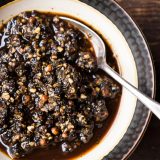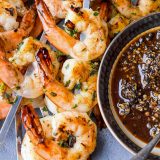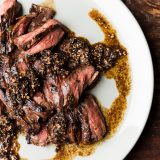The beer would flow copiously. By the bucketful, actually. So I’d been warned about Cambodian weddings. And this gathering of 700 or so guests in a rollicking white banquet hall on the steamy outskirts of Siem Reap certainly matched that billing. Dozens of waiters carried large metal buckets of canned beer from table to table, never asking, simply replacing any—empty or not—set down for more than a moment.
Which actually mitigated the awkwardness of not knowing a single person at the wedding. Not the bride, a flow of glittering white and gemmed crown. Not the groom, his wrists wrapped in a splash of red blessing strings. Not the 697 or so other guests.
Actually, I did know one person. My waiter. Not my beer-bearing wedding waiter. The waiter from Pou Kitchen and Café, the chic, airy restaurant where I’d had lunch earlier that day. The waiter who had spontaneously invited me to his boss’ wedding that evening. Because, he assured me, I had to try the food at a Cambodian wedding, a ridiculous onslaught of platter upon platter of food. He hadn’t lied.
The bold pageantry unfolds with gilded attendants dancing barefoot before a towering tiered cake heaped with flowers and ringed with golden, tree-like lace. Children clamber onstage, jumping and rolling as they perform skits mimicking monkeys. And at times inexplicably random to me, the entire room swarms forward to join together for a slow-motion circulating dance around the cake.
Amidst all the happy chaos and flamboyant choreography—the bride and groom slice the cake with a sword—waiters so numerous they wear number tags, not names, weave and dart between tables, heaping platter upon platter of food onto massive glass lazy Susans. There barely is time to taste one dish before another, then another, then another join it. Each with a fresh can of beer, of course.
Cooling sweet-and-sour pickles and fiery fermented cabbage. A basil-rich mango chicken salad. Shatteringly crisp fried river fish. Bowls of cashews. Hunks of beef dried to a tofu-like texture. A platter of pork intestines and cabbage. Don’t forget the beers. Tangy, thinly sliced pork with red onions. Something I think is duck, but I’m losing track. Hot pot. Fried rice. Stir-fry.
The options add up and spin at the center of each table as the 11 pairs of chopsticks seated at mine reach inward. The one thing I don’t share, won’t share, is a tiny condiment bowl that contains a dark, grainy, almost gritty sauce. I dip a bite of pork and taste—my mouth pops with sweet lime and fire.
I immediately recognize it as the pepper-lime dipping sauce I’d had at lunch, a simple mix of coarse black pepper, lime juice, sugar and salt. Though traditionally served with the rich beef stir-fry loc lac, it’s actually as ubiquitous as ketchup is in the U.S. The sweet heat of the pepper and brightness of the citrus balance all manner of meaty dishes.
I spend the rest of my visit to Cambodia seeking it out everywhere. It proves easy to find. And though some are better balanced than others, all follow the same delicious four-ingredient equation. Which made it an easy recipe to replicate back at Milk Street.
How to serve pepper-lime sauce? The answer is as simple as the recipe. With everything. We like it as a dipping sauce for grilled chicken and spooned liberally over roasted cauliflower. We also love it with a sweet-and-tangy cilantro-lime grilled shrimp that, like the sauce itself, can be made in just minutes.
And in a nod to the sauce’s loc lac origins, we found that strip steak prepared similar to the shrimp also was a good match for the sauce. But however you serve it, make sure to have a bucket of beer to wash it down.






